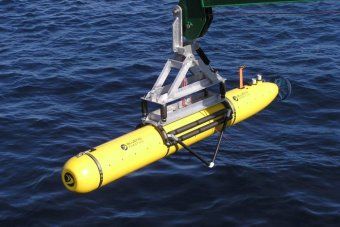The autonomous underwater vehicle was sent on its second underwater journey on Tuesday night, leaving from the Australian vessel Ocean Shield.
The Joint Agency Coordination Centre said data from Bluefin-21's first mission had not captured any debris or other objects of interest.
The unmanned submarine's first mission had to be cut short after it exceeded its depth limit of 4,500 metres and an inbuilt safety feature brought it back to the surface.
What is the Bluefin-21?Authorities say it takes two hours for Bluefin-21 to reach the ocean floor.
- An autonomous underwater vehicle (AUV) designed for deep-sea surveying.
- It has a "swappable payload". It will first use sonar in the search and will be refitted with cameras if something is detected.
- It's 5m long and weighs 750kg. Has an endurance of 25 hours underwater at a speed of 3 knots, with a top speed of 4 knots.
- It has a depth rating of 4,500m, meaning it will be at its limit in the Indian Ocean search zone.
- Bluefin Robotics says its AUV can also be used for archaeology, oceanography, mine countermeasures, and unexploded ordnance.
Wednesday's search for the missing plane will include 11 military aircraft, three civil planes and 11 ships.
Poor weather is expected to bring showers and sea swells of up to two metres to the area.
The flight vanished off radar screens on March 8 while en route from Kuala Lumpur to Beijing with 239 people on board, including six Australians.
The submarine was launched after authorities gave up hope of relocating underwater signals from MH370's flight recorders.
On Monday, search coordinator Retired Air Chief Marshal Angus Houston said no acoustic trace of the plane's black box had been detected for six days.
"We haven't had a single detection in six days ... so I guess it's time to go underwater," he said at the time.
The black box, which refers to two orange boxes that record flight data and cockpit chatter, may provide answers about what happened to the plane.
Wreck hunter confident plane will be found
One of the world's foremost wreck hunters believes searchers have found the crash site of the missing jet, and recovering the black boxes is inevitable.
Video: Finding the wreckage of MH370 is inevitable according to 'wreck hunter' David Mearns (7.30)
"I think essentially they have found the wreckage site," the director of the UK-based Bluewater Recoveries, David Mearns, told 7.30.
"While the Government hasn't announced that yet, if somebody asked me: 'Technically, do they have enough information to say that?' my answer is unequivocally 'Yes'."
Mr Mearns solved one of Australia's greatest maritime mysteries when he found the wreck of HMAS Sydney deep in the Indian Ocean.
He was awarded an honorary Order of Australia for his work.
He said his confidence about the MH370 work was based on the strength of the sonar "pings" emitted from the plane's black box recorders.
"You just don't hear these signals randomly in the ocean. These are not fleeting sounds, they have got four very, very good detections, with the right spectrum of noise coming from them. It can't be from anything else," he said.
Despite his confidence, Mr Mearns says he would be surprised if the search turned up anything quickly.
He expected it would take weeks, if not months, to recover the black boxes from the Boeing 777.




Then what can we do to get them back?
If I don't understand something, it really annoys me that I'm not allowed to help, especially if so many lives are affected and I don't just mean those on board the plane.